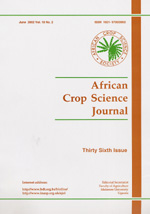
|
African Crop Science Journal
African Crop Science Society
ISSN: 1021-9730
EISSN: 1021-9730
Vol. 21, No. s3, 2013, pp. 647-656
|
 Bioline Code: cs13036
Bioline Code: cs13036
Full paper language: English
Document type: Research Article
Document available free of charge
|
|
|
African Crop Science Journal, Vol. 21, No. s3, 2013, pp. 647-656
| en |
Tree and Shrub Species Integration in the Crop-Livestock Farming System
Sisay, Mulugeta & Mekonnen, Kindu
Abstract
Tree and shrub integration has been promoted as a means of enhancing rural livelihoods through sustaining watershed provision of services and products, especially in Ethiopia. However, research to support this effort has been limited. This study was conducted in Borodo watershed in central Ethiopia, to identify constraints to the process of tree and shrub integration in the watersheds. A household survey was conducted, supplemented with focus group discussions (FGDs), key informant interview and field observations. A total of 31tree and 11 shrub species were identified in different niches in the watershed. The key constraints to tree and shrub species integration included shortage of arable land, soil cracking, free grazing, lack of seedlings of desired species and water-logging. The main catalysts to the integration were availability of information on improved integration and cash for investment in the required activities, easy land certification and market opportunity for tree and shrub products. The tree and shrub growing niches preferred by farmers were homesteads (95.5%), gully sides (67.4%), stream sides (61.8%) road sides (60.7%), and crop land (12.4%). It is essential to address the factors that hinder tree and shrub species integration at various growing niche so as to improve the availability of tree products and services. Moreover, the capacity of farmers should be upgraded through training and demonstration of best tree planting, management and utilisation practices.
Keywords
Household; landscape; niche; watershed
|
| |
| fr |
Sisay, Mulugeta & Mekonnen, Kindu
Résumé
L’intégration arbre-arbuste a été promue comme moyen d’améliorer les conditions de vie en milieux ruraux par la fourniture durable dans le bassin versant des services et produits, spécialement en Ethiopie. Par ailleurs, la recherche pour appuiyer cet effort a été limitée. Cette étude était conduite dans le basin versant de Borodo en Ethiopie Central, afin d’identifier les contraintes au processus d’intégration arbre-arbuste dans les bassins versants. Une enquête de ménages supplémentée par les groupes focaux de discussion était conduite, l’interview des personnes clées et des observations sur terrain.Un total de 31 espèces d’arbres et 11 arbustes étaient identifiées dans différentes niches de bassins versants. Les contraintes majeurs à l’intégration des espèces d’arbres et arbustes comprenaient la rareté des terres arables, le craquement du sol, la divagation du betail, manqué de plants des espèces désirés et innondation. Les pricipaux catalysants de l’intégration étaient disponibilité de l’information et le fonds d’investissement dans ces activitvs, la facilité de certilification des terres et l’opportunité du marché des produits d’arbres et arbustes. Les niches de production d’arbres et arbustes préférées par les fermiers étaient le voisinages de maisons (95.5%), le long des ravins (67.4%), le long des ruisseaux (61.8%), le long des routes (60.7%) et les terres reservées aux cultures (12.4%). Il est essentiel d’addresser les facteurs qui affectent l’intégration des espèces d’arbres et arbustes dans différentes niches de production afin d’améliorer la disponibilité des produits et services de bois. En plus, la capacité de fermiers pourrait être améliorée à travers la formation et la démonstration de meilleurs façons de planter les arbres, la gestion et les pratiques d’utilisation.
Mots Clés
Ménage; paysage; niche; bassin versant
|
| |
© African Crop Science Journal
|
|
